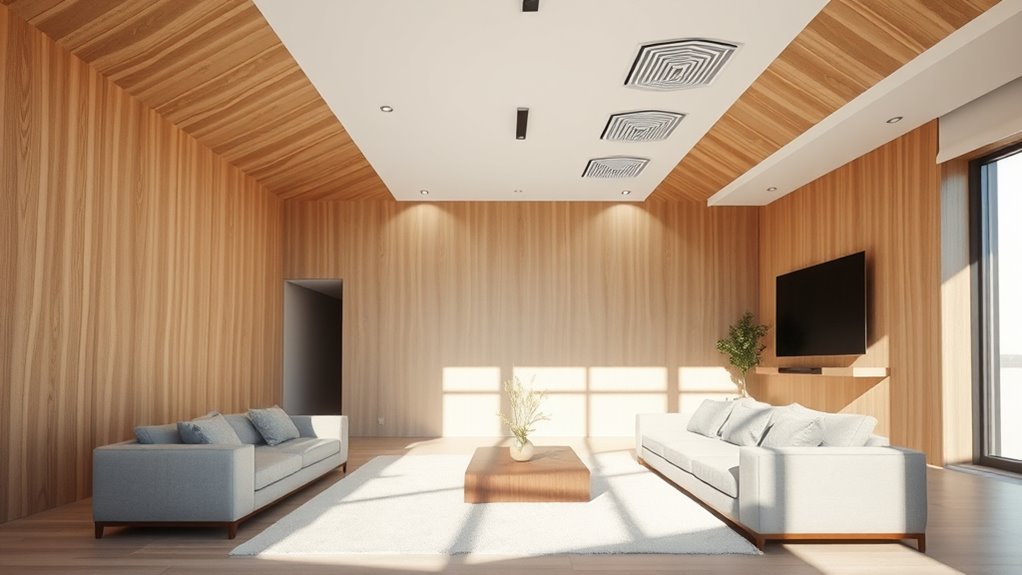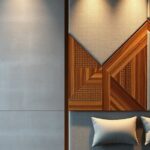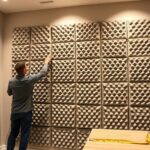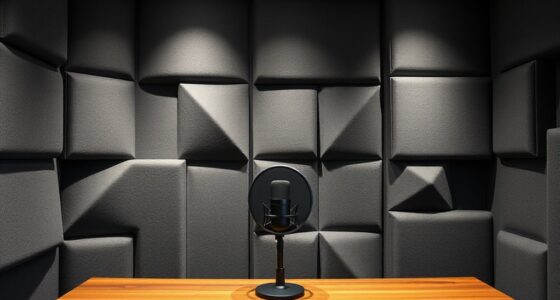To improve acoustic design in your open plan living space, you should focus on using soundproofing materials like dense insulation and acoustic barriers to block noise, especially from kitchens or conversations. Incorporate acoustic panels made from porous materials that absorb sound, reducing echoes and reverberation. Stylish and functional, these solutions help create private zones and balance openness with noise control, making your space calmer. Keep exploring to discover effective strategies tailored to your needs.
Key Takeaways
- Use sound-absorbing materials like acoustic paneling to reduce echoes and reverberation in open spaces.
- Incorporate dense insulation and soundproofing barriers within walls and ceilings to minimize noise transfer.
- Strategically place acoustic panels near noisy zones or sound reflections for optimal sound management.
- Combine aesthetic design with functional acoustic solutions to create private zones without compromising openness.
- Enhance overall comfort and privacy by balancing openness with targeted sound absorption and isolation measures.

Good acoustic design can transform your living space into a more comfortable and peaceful environment. When you’re dealing with an open plan layout, noise can easily become a problem. Sounds from the kitchen, living room, or even conversations can blend together, making it hard to relax or focus. That’s where thoughtful use of soundproofing materials and acoustic paneling makes a real difference. By strategically incorporating these elements, you can control how sound travels and create zones within your open space that feel calm and private.
Soundproofing materials are your first line of defense. These are designed to absorb or block sound waves, preventing noise from traveling between areas. For example, installing dense insulation in walls or ceilings can significantly reduce noise leakage. You might also consider adding mass-loaded vinyl or specialized acoustic barriers behind drywall to enhance soundproofing. If you have a home office or media area, these materials can help keep noise contained, so you don’t interfere with other activities. Their installation might involve some effort, but the results are worth it—you’ll notice a marked decrease in unwanted noise and an increase in overall tranquility.
Alongside soundproofing materials, acoustic paneling plays a vital role in shaping your space’s sound environment. Acoustic panels are often made from porous materials that absorb sound waves rather than reflecting them. Placing these panels on walls or ceilings helps to dampen echoes and reduce reverberation. You can choose from a variety of styles and colors to match your interior decor, making acoustic paneling both functional and aesthetically pleasing. Strategic placement is key—position panels near noisy areas or at points where sound waves tend to bounce. This setup creates a more controlled acoustic environment, making conversations clearer and music or TV sounds more comfortable.
In open plan living spaces, you don’t have to sacrifice style for function. Modern soundproofing materials and acoustic paneling are available in sleek, attractive designs that blend seamlessly into your decor. You can create zones within your space—such as a quiet reading nook or a home office—by using these acoustic solutions to dampen sound in specific areas. This way, you enjoy the openness and social vibe of your layout without the chaos of noise interference. Additionally, understanding the Louisiana Alimony Laws can help you plan your post-divorce financial arrangements more effectively. With the right combination of soundproofing materials and acoustic paneling, you’re empowered to craft a living environment that’s peaceful, functional, and visually appealing. It’s all about making intentional choices to enhance your comfort and quality of life in your open plan home.
Frequently Asked Questions
How Do I Reduce Echo in High-Ceiling Open Areas?
To reduce echo in high-ceiling open areas, you should focus on wall treatments and ceiling modifications. Add soft materials like fabric wall panels, art, or bookshelves to absorb sound. You can also install acoustic ceiling tiles or hang fabric drapes to break up sound waves. These solutions help dampen echoes, creating a more comfortable and acoustically balanced space without sacrificing the open feel.
What Materials Best Absorb Sound in Open-Plan Kitchens?
Imagine a soft, velvety curtain gently draping across your kitchen opening—soundproof curtains are excellent for absorbing noise and reducing echoes. Acoustic panels, with their textured surfaces, also effectively trap sound waves, preventing noise from bouncing around. Combining these materials creates a cozy, quiet environment amid your open-plan space, making conversations clearer and reducing overall noise levels. You’ll enjoy a more serene kitchen atmosphere effortlessly.
Can Furniture Placement Improve Acoustics in Large Rooms?
Yes, furniture arrangement can markedly improve acoustics in large rooms. By strategically placing sofas, chairs, and rugs, you create zones that reduce echo and sound travel. Incorporate decorative accessories like fabric curtains, cushions, and wall hangings to absorb sound further. You’ll find that thoughtful furniture placement and these accessories help create a more comfortable, acoustically balanced open space, making conversations clearer and overall noise levels more controlled.
How Does Outdoor Noise Impact Indoor Acoustic Design?
Imagine outdoor noise sneaking into your home, disrupting your peace. Outdoor noise impacts indoor acoustic design by creating unwanted sound disturbances. To combat this, you should focus on outdoor noise mitigation strategies, like planting dense greenery or installing outdoor sound barriers. These barriers help block and absorb noise before it reaches your space, ensuring a quieter, more comfortable indoor environment despite the noise outside.
Are There Eco-Friendly Acoustic Solutions for Open Spaces?
Yes, you can choose eco-friendly acoustic solutions for open spaces. Opt for recyclable materials like cork panels or reclaimed wood to absorb sound naturally. Biodegradable solutions, such as hemp or natural fiber panels, also help reduce environmental impact. These options not only improve acoustics but also support sustainability, making your space environmentally responsible while maintaining effective sound control.
Conclusion
As you step into your open plan living space, you notice how the gentle hum of conversation and soft rustling of fabrics blend seamlessly, creating a harmonious sanctuary. Thoughtful acoustic design transforms your home into a refuge where sound flows effortlessly, like a calming breeze through open windows. With careful planning, you craft an environment that feels both lively and tranquil, inviting you to relax and enjoy every moment surrounded by balanced, soothing acoustics.















